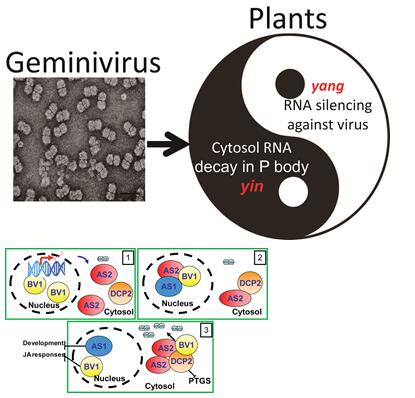
In Chinese philosophy, everything contains yin and yang. Birth and death, the two major topics of life sciences, also form a yin-yang pair. Plants and animals defense themselves against invasive nucleic acid such as infectious pathogens and endogenous transposable elements by RNA silencing machinery.
Turn-on and turn-off of RNA silencing is another yin-yang pair. Like most eukaryotic mRNAs, viral mRNAs transcribed from DNA viruses are capped at their 5′ ends to increase stability and enhance translational efficiency. Therefore, removal of 5′ caps from viral mRNAs may be considered as an anti-viral response or yang factor in host immunity against viral diseases. But the role of decapping in host defense in both animals and plants were unclear.
Prof. YE Jian’s group at the Institute of Microbiology of Chinese Academy of Sciences, together with Prof. FANG Rongxiang at the same institute and Prof. Nam-Hai Chua’s lab in Rockefeller University, USA, recently unraveled a general mechanism of how decapping machinery in Processing body (P body) acts as a yin factor instead of common sense as yang factor. The formation of P body promotes accumulation of various geminiviruses including Cassava Mosaic virus. The whitefly-transmitted geminiviruses have recently emerged as one of the most destructive pathogens in the past decade, causing billons US dollars lose annually.
YE and his colleagues identified a yin factor of RNA silencing: ASYMMETRIC LEAVES2 (AS2), a well-known leaf stem cell regulator as the name suggested, as a new component of plant P body complex. They found that AS2 promotes the enzyme activity of DCP2, the key player in removing cap of 5′ ends of mRNAs-decapping activity and accelerating mRNA turnover rate and functions as an endogenous suppressor of RNA silencing. Consistent with these findings, as2 mutant plants are resistant to virus infection whereas AS2 over-expression plants are hypersensitive.
Instead of interfering yang factor by other known virulent factors, the geminivirus nuclear shuttle protein BV1 protein, which shuttles between nuclei and cytoplasm, promotes the yin factor-AS2’s expression, causing nuclear exit of AS2 to activate DCP2 decapping activity and rendering infected plants more sensitive to viruses.
These principles of gene induction and shuttling of expressed protein to promote yin factor’s activity in the cytosol may be used by viral pathogens to promote virus pathogenesis in host plants. Similar mechanisms may be used by other viral pathogens to weaken antiviral defenses in host plants and mammals.
This work identified a conserved yin factor of RNA silencing. So far there is no efficient virus resistance strategy against geminiviruses. Since these yin factors are essential for geminivirus replication and survival in plant host, they offer a good target to generate broad geminivirus resistance in various crops such as cassava and tomato. With marker assistance breeding or the newly developed genome editing on these yin factors, it will be possible to generate high immunity against the geminiviral diseases.
The work was supported by the Strategic Priority Research Program Grant from Chinese Academy of Sciences (NO. XDB11040300) and Natural Science Foundation of China, NSFC31522046. The study was published in PLoS Pathogens.

Figure: Geminivirus promotes a yin factor to promote virus accumulation. (Image by YE Jian et al. Credit: PLoS Pathogens 2015).

86-10-68597521 (day)
86-10-68597289 (night)

86-10-68511095 (day)
86-10-68512458 (night)

cas_en@cas.cn

52 Sanlihe Rd., Xicheng District,
Beijing, China (100864)

